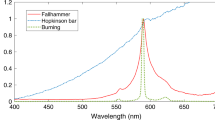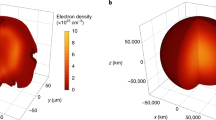Abstract
THE phenomena connected with active nitrogen and its afterglow have recently received a great deal of attention. A view almost generally accepted now is that the afterglow is due to the recombination of nitrogen atoms produced in the discharge. Though it has not been possible hitherto to determine thermochemically the heat of dissociation of molecular nitrogen, a value a little above the equivalent of 11 volts has been found for it from the characteristics of its band spectrum. On the recombination of two atoms taking place to form a molecule this amount of energy may be transferred to a second molecule, and it is just sufficient to excite the afterglow bands. This view, it may be stated, is based on the assumption that the initial states giving rise to the first positive group of bands are the same as the final states involved in the production of the second and fourth positive group. The vibrational levels seem to be identical; the rotational levels have not yet been analysed.
This is a preview of subscription content, access via your institution
Access options
Subscribe to this journal
Receive 51 print issues and online access
$199.00 per year
only $3.90 per issue
Buy this article
- Purchase on Springer Link
- Instant access to full article PDF
Prices may be subject to local taxes which are calculated during checkout
Similar content being viewed by others
References
Jour. Opt. Soc, Am., 14, p. 17; 1927. Zeit. f. Physik, 29, p. 345; 1924.
Author information
Authors and Affiliations
Rights and permissions
About this article
Cite this article
MCLENNAN, J., RUEDY, R. & ANDERSON, J. The Nitrogen Afterglow. Nature 121, 537–538 (1928). https://doi.org/10.1038/121537b0
Issue Date:
DOI: https://doi.org/10.1038/121537b0
Comments
By submitting a comment you agree to abide by our Terms and Community Guidelines. If you find something abusive or that does not comply with our terms or guidelines please flag it as inappropriate.



